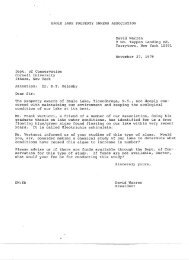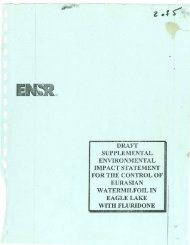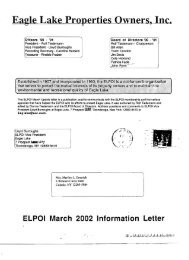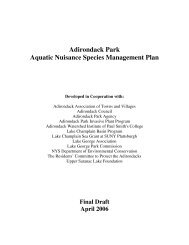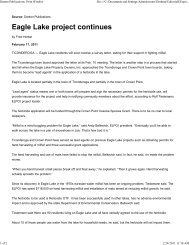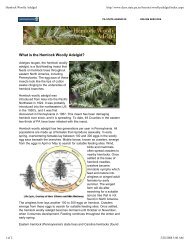Maine Field Guide to Invasive Aquatic Plants - Brant Lake Milfoil ...
Maine Field Guide to Invasive Aquatic Plants - Brant Lake Milfoil ...
Maine Field Guide to Invasive Aquatic Plants - Brant Lake Milfoil ...
Create successful ePaper yourself
Turn your PDF publications into a flip-book with our unique Google optimized e-Paper software.
EUROPEAN FROG-BIT<br />
Hydrocharis morsus-ranae<br />
NOT NATIVE TO MAINE - INVASIVE<br />
I N V A S I V E P L A N T S<br />
Habitat: European frog-bit (or frog’s bit) is found in the floatingleaved<br />
plant community. It is a free-floating plant that thrives in<br />
open marsh habitat and quiet backwaters, forming dense floating<br />
colonies.<br />
Description: European frog-bit is a small free-floating aquatic<br />
plant. Its small kidney or heart shaped leaves (1.5 <strong>to</strong> 6.5 cm<br />
long) are not anchored <strong>to</strong> the bot<strong>to</strong>m sediments. The leaves have<br />
elongated stalks (4-6 cm long) and occur in clumps, forming a<br />
bouquet-like rosette. Unbranched root-like tendrils (resembling<br />
slender bottle brushes) dangle below. The flowers of European<br />
frog-bit have three white petals with a yellow center.<br />
Origin and US Range: European frog-bit is<br />
native <strong>to</strong> Europe. It is not native <strong>to</strong> New<br />
England and is considered invasive <strong>to</strong> this<br />
area. Nearby populations occur in Vermont<br />
and New York.<br />
Annual Cycle: European frog-bit is an aquatic perennial that<br />
propagates primarily by vegetative means. Mature plants send<br />
out multiple offspring on trailing runners (s<strong>to</strong>lons). Winter buds<br />
(turions) form during the summer, and fall <strong>to</strong> the bot<strong>to</strong>m as<br />
plants begin <strong>to</strong> decay at the end of the growing season. In the<br />
spring the turions break dormancy, bob <strong>to</strong> the water surface,<br />
and sprout new growth. Flowers, followed by fruits, occur during<br />
the summer.<br />
Look Alikes: May be<br />
confused with fragrant<br />
water-lily, little floating<br />
heart, spatterdock and<br />
watershield.<br />
European frog-bit<br />
20 <strong>Maine</strong> Volunteer <strong>Lake</strong> Moni<strong>to</strong>ring Program



